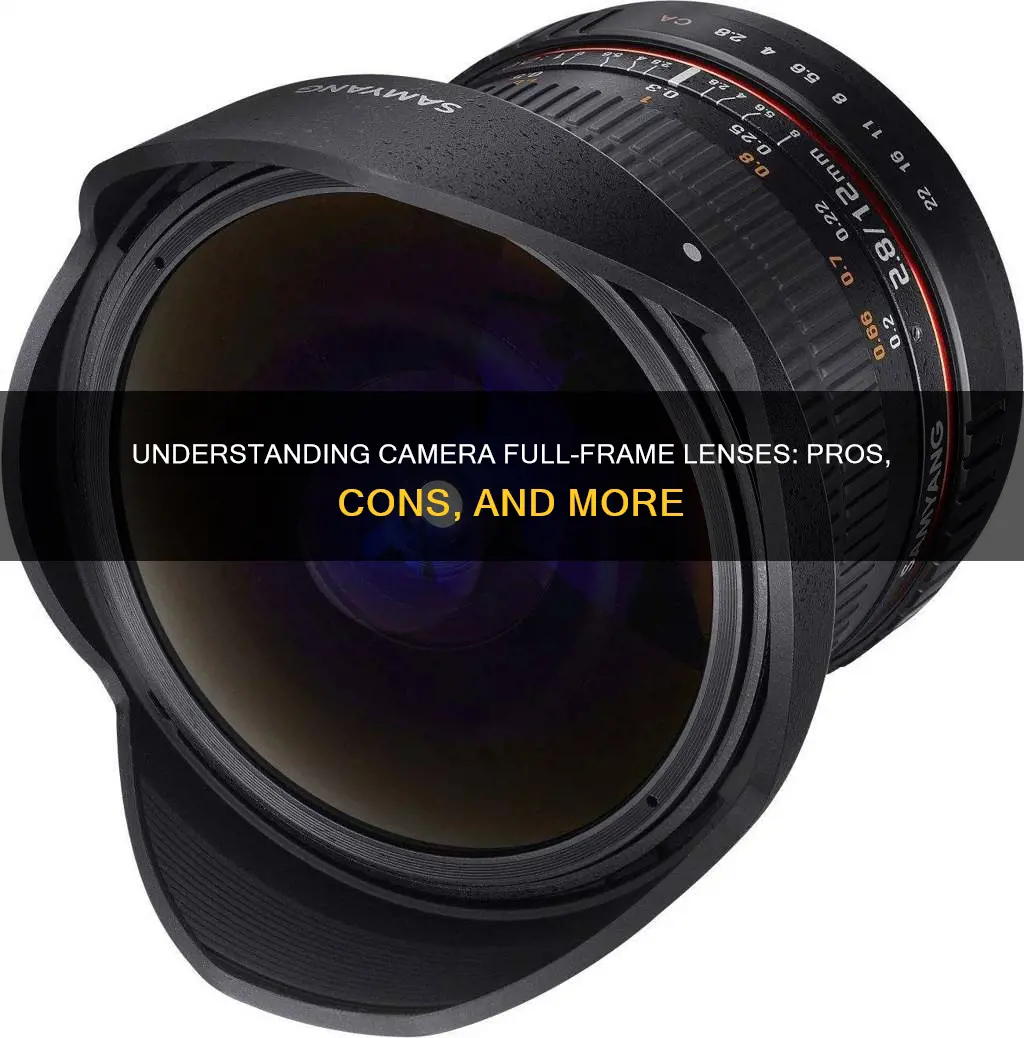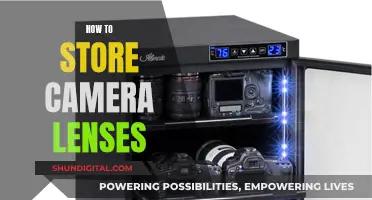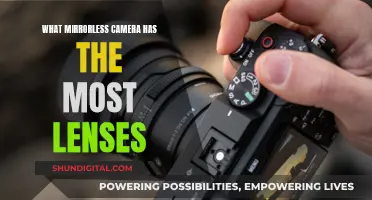
The sensor in a full-frame camera is the same size as a 35mm film frame, measuring 36mm x 24mm. This is larger than the sensors in crop-frame cameras, which are typically APS-C sensors. The larger sensor in a full-frame camera offers several advantages, including a wider field of view, better low-light performance, and a shallower depth of field. However, full-frame cameras also have some disadvantages, such as increased cost, bulk, and weight.
| Characteristics | Values |
|---|---|
| Image sensor size | 36mm x 24mm (3:2 aspect ratio) |
| Image sensor type | Digital |
| Image quality | Higher resolution, less noise, better low-light performance, sharper image, greater dynamic range |
| Lens compatibility | Requires full-frame lens mount; some lenses designed for 35mm film cameras can be used with an adapter |
| Price | More expensive than crop-sensor cameras |
| Size and weight | Bulkier and heavier than crop-sensor cameras |
| File size | Larger file sizes due to higher resolution |
What You'll Learn

Full-frame cameras have no crop factor
A full-frame camera has a sensor the same size as a full frame of 35mm film, measuring 36mm x 24mm. This is the standard in film gauge, set since 1909 due to its image quality abilities and balance in cost. Full-frame cameras have no crop factor, meaning the image is not cut off because the sensor is large enough to capture the entire image.
Crop factor means that the image is cropped as the sensor is too small to capture the entire image. The ratio of the size of the full-frame 35mm format to the size of the smaller format is known as the "crop factor" or "focal-length multiplier". The crop factor varies by camera brand: Canon has a 1.6x crop factor, Nikon, Sony, Sigma, and Pentax have a 1.5x multiplier, and Panasonic and Olympus are 2x.
A full-frame camera with a 50mm lens will give you a 50mm image angle. On a camera with an APS-C sensor, the image angle is reduced to 33.3mm. A full-frame camera will also give you the full image angle of your wide-angle lens.
Full-frame cameras are ideal for shooting in low-light situations. The larger sensor size allows more light to be captured, resulting in clearer and sharper photos. The larger sensor also means that full-frame cameras have a smaller depth of field, making it easier to make your subject stand out from the background. This is useful in portrait and macro photography.
Full-frame cameras are often considered the tool of choice for professional photographers. They are typically found in high-quality DSLR cameras and mirrorless devices. However, they tend to be bulkier and more expensive than crop sensor cameras.
Lens Quality Impact: Does Better Glass Mean Better Photos?
You may want to see also

Full-frame cameras are better in low-light conditions
A full-frame camera is a digital single-lens reflex camera (DSLR) with a 35 mm image sensor format, measuring 36 mm x 24 mm. This is the same size as a frame of 35 mm film, and it is the reference format to which all other sensors are compared.
Full-frame cameras also offer a greater dynamic range, providing more detail in the extremes of light and dark. This means that photographers can capture more contrasty images and are more likely to be able to save an over or underexposed image with post-processing. Additionally, full-frame cameras have lower noise levels at high ISO, which is beneficial in low-light situations.
The larger sensor size of a full-frame camera also affects the depth of field. Full-frame sensors have a smaller depth of field than other sensors, making it easier to make the subject stand out from the background. This can be particularly useful in portrait and macro photography.
While full-frame cameras offer advantages in low-light conditions, there are some trade-offs to consider. Full-frame cameras tend to be larger and heavier than their crop-sensor counterparts, and they are usually more expensive. Additionally, there may be compatibility issues with lenses, as not all lenses will fit on a full-frame camera.
Protect Your Camera Gear: Insuring Cameras and Lenses
You may want to see also

Full-frame cameras are heavier and more expensive
Full-frame cameras offer a range of benefits, but they do come with some drawbacks, including increased weight and cost.
Full-frame cameras are heavier than their cropped-sensor counterparts. The larger sensors in full-frame cameras require larger camera bodies to accommodate the increased sensor size. This added bulk can make full-frame cameras more challenging to carry around, especially when paired with larger lenses.
The production costs of full-frame sensors are significantly higher than those of cropped sensors. The larger size of full-frame sensors means that fewer sensors can be produced in a single production run, driving up the cost. Additionally, full-frame cameras are often designed for professional use, with more features and rugged construction, further contributing to their higher price tags.
Full-frame cameras offer advantages such as wider angles, larger photosites, greater creative control, better dynamic range, and improved performance in low-light conditions. However, these benefits come at the cost of increased weight and expense.
The weight and cost of full-frame cameras can be significant factors for photographers, especially those who need to travel with their equipment or are working with limited budgets. While full-frame cameras offer superior image quality, the trade-offs in terms of weight and cost may lead some photographers to opt for cropped-sensor cameras, which offer their advantages and are more lightweight and affordable.
Camera Lenses: Retaining Value Over Time?
You may want to see also

Full-frame cameras produce larger image files
A full-frame camera is a digital single-lens reflex camera (DSLR) with a 35 mm image sensor format, measuring 36 mm x 24 mm. This is the same size as a frame of 35mm film, with an aspect ratio of 3:2. The larger sensor size of a full-frame camera offers several advantages, including the ability to capture more light and detail, resulting in higher image quality. This is especially beneficial in low-light conditions, where a full-frame camera can produce sharper and clearer images with less noise and more detail.
The larger sensor size also provides a wider angle of view, which can be advantageous for certain types of photography such as landscape, architecture, and real estate photography. Additionally, full-frame cameras offer a greater dynamic range, allowing for higher contrast images and better performance in both over and underexposed shots. The larger sensor also enables a shallower depth of field, which can be beneficial for portraiture, food photography, and other types of photography that benefit from a blurred background.
However, one of the main disadvantages of full-frame cameras is that they produce larger image files. The larger sensor captures more data, resulting in larger file sizes. This means photographers need to invest in additional storage solutions, such as faster memory cards, cloud storage, or backup drives. The cost of storing and managing these larger image files can be significant, especially for photographers who shoot in RAW format.
Another consideration is the higher price tag associated with full-frame cameras. The larger sensors come with a higher production cost, which is reflected in the retail price. Additionally, full-frame cameras often require the purchase of specialised full-frame lenses, which can be expensive. The bulkier size of full-frame cameras and lenses can also be a disadvantage for photographers who need a more portable setup, such as those specialising in travel, street, or photojournalism.
In summary, while full-frame cameras offer several benefits, including improved image quality, low-light performance, and a wider angle of view, they also come with the trade-off of larger file sizes, higher costs, and increased bulk. Photographers need to consider their specific needs and budget when deciding between a full-frame or crop-sensor camera.
Sigma Lenses: Compatible with Full-Frame Cameras?
You may want to see also

Full-frame cameras offer greater creative control
A full-frame camera is a digital single-lens reflex camera (DSLR) with a 35 mm image sensor format (36 mm x 24 mm). This is the same size as a frame of 35mm film, with an aspect ratio of 3:2. This larger sensor size offers a range of benefits, including greater creative control for photographers.
Full-frame cameras offer a wider angle of view than crop sensor cameras. This means that a lens will have a wider angle of view on a full-frame camera than on a crop sensor camera. This can be particularly beneficial for photographers working in genres such as landscape photography, real estate photography, architecture photography, or any other type of photography that requires a wide frame.
Full-frame cameras also offer a shallower depth of field than crop sensor cameras, allowing for more creative control over the background blur, or "bokeh", effect. This can be advantageous for portrait photography, food photography, or any other type of photography that benefits from a blurred background.
The larger sensor size of full-frame cameras results in larger photosites, which are the tiny light collectors on a sensor that record the pixels in an image file. Larger photosites mean less digital noise and better colour accuracy, resulting in higher overall image quality. This is particularly noticeable in low-light conditions, where full-frame cameras offer superior performance compared to crop sensor cameras.
Full-frame cameras also offer a greater dynamic range, capturing far more detail in the extremes of light and dark. This allows photographers to shoot higher-contrast images and recover over or underexposed images more easily in post-processing.
While full-frame cameras offer greater creative control, they also come with some disadvantages. They tend to be bulkier, heavier, and more expensive than crop sensor cameras. They also produce larger image files, which can increase storage requirements and costs.
Old Lenses, New Cameras: Is There Compatibility?
You may want to see also
Frequently asked questions
A full-frame camera is a digital camera with an image sensor that is the same size as a full frame of 35mm film, measuring 36mm x 24mm with a 3:2 aspect ratio. This larger sensor offers advantages such as wider angles, better low-light performance, and a shallower depth of field.
Full-frame cameras offer several benefits over crop-sensor cameras. These include:
- Wider angles
- Better low-light performance due to larger pixels that capture more light
- Greater dynamic range and tonal accuracy
- Shallower depth of field, allowing for a more blurred background (bokeh)
- Higher overall image quality
Yes, full-frame cameras tend to be heavier, more expensive, and produce larger file sizes due to the increased data captured by the larger sensor.
The choice between a full-frame and a crop-sensor camera depends on your photography needs and goals. Full-frame cameras are typically favoured by professionals due to their superior image quality, dynamic range, and low-light performance. However, crop-sensor cameras offer advantages such as smaller size, lower cost, and better telephoto capabilities, making them a good choice for sports or wildlife photography.
It depends on the brand. Some full-frame lenses may require an adapter to be used on a crop-sensor camera, and even then, the image circle may be vignetted, resulting in cropped images. However, using full-frame lenses on a crop-sensor camera can provide benefits such as improved image quality.







